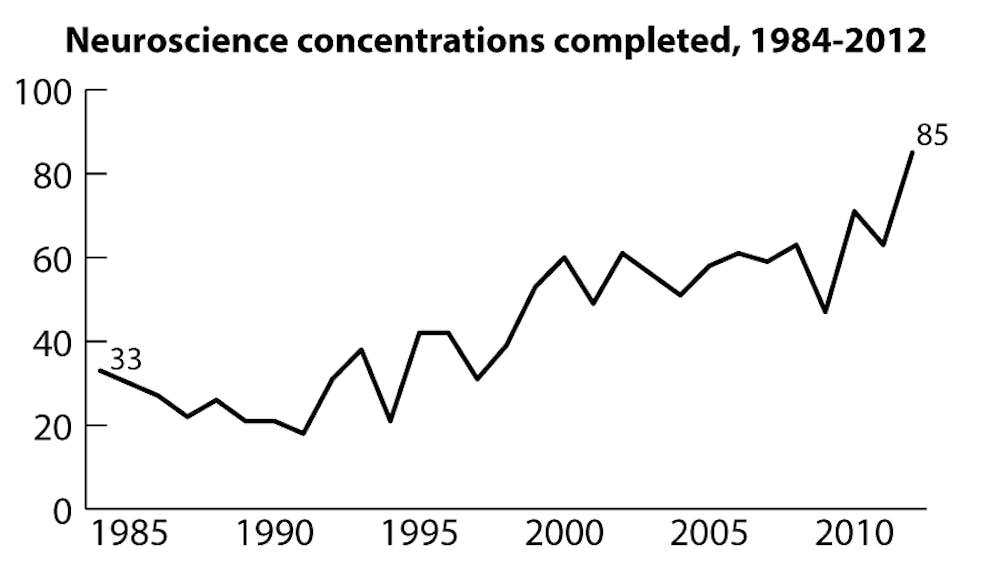Over roughly the past 20 years, neuroscience has steadily strengthened its presence at Brown, boasting consistently growing numbers of undergraduate concentrators and centering around the Brown Institute for Brain Sciences, a premier research framework.
President Obama unveiled a plan this week to commit at least $100 million to the brain sciences by 2014. “The most powerful computer in the world isn’t nearly as intuitive as the one we’re born with,” he said.
Brown students interests seem to align with the president’s focus on understanding the brain — there were a record 85 neuroscience degrees earned in the class of 2012, the seventh time since 2000 that there were at least 60 concentrators in a graduating class, according to data obtained by The Herald from the Office of Institutional Research. In the class of 1994, there were only 21 neuroscience concentrators.
“People are inherently fascinated with the brain,” said Professor of Neuroscience Barry Connors, chair of the department. “It’s not clear to me why anyone would study something other than the brain.”
“It’s just really interesting how some random cells control our physical and emotional states,” said Carolina Santiago ’16, who said she will likely concentrate in neuroscience. “We kind of know how a lot of things work in other sciences, but we don’t know as much about the brain, which makes it exciting.”
Adam Loewentheil ’16, who is considering concentrating in neuroscience, wrote in an email to The Herald, “I’m considering neuro out of pure interest for the subject ... especially how emotions, drives and changes can be explained by what goes on on the microscopic level in our brains.”
The department has also developed and sustained a reputation for high-quality teaching, students said.
Some students said they were especially drawn to the concentration for its faculty and staff. NEUR 0010: “The Brain: An Introduction to Neuroscience” has an almost 30-year-long history at Brown, and about 48 percent of Critical Review survey respondents in the class said they were not taking it to fulfill a requirement in fall 2011, the most recent semester for which the course’s data is available.
But not all students were enthusiastic about their experiences in the department. NEUR 0010 is the only neuroscience class Cale Bonderman ’15 has taken, and he gave the course a mixed review. “The lectures were engaging and informational, but ... the amount of content and the arbitrary little stuff they tested for was completely ridiculous,” he said. “It’s an intro class, but they expect you to know every last detail.”
Many neuroscience concentrators are also pre-medical students. Many of the requirements for the neuroscience Sc.B. map neatly onto the prerequisites students need to fulfill to apply to med school, including background courses in physics, biology and organic chemistry. “The requirements for neuro and the requirements for pre-med are basically the same,” Santiago said. “And that way I can take more classes outside of my concentration while getting a science degree.”
The concentration also offers a degree of flexibility, allowing for four electives related to neuroscience and encouraging “independent study and honors research projects,” according to the department’s website.
Neuroscience is a relatively young field and “was barely on the radar when I was an undergraduate,” Connors said. But newness seems to have given rise to the impression among students and academics, both in and out of Brown, of opportunity and growth.
The University has invested in brain sciences research as one of its major initiatives over the past several years.
The Sidney E. Frank Hall for Life Sciences, which cost $95 million, was constructed in 2006 to house the neuroscience department and the Department of Molecular Biology, Cell Biology and Biochemistry. The building that houses the Department of Cognitive, Linguistic and Psychological Sciences — Metcalf Chemistry and Research Laboratory — underwent a $42 million renovation completed in 2012, The Herald previously reported.
Beyond Brown, membership of the American Society of Neuroscience has increased to 42,000 this year, according to the society’s website, and reflects “the same growth trend” seen among Brown students, Connors said.
Hand in hand with this phenomenon, the University is priming its brain sciences research program to stay at the forefront of the field in coming years. The Brown Institute for Brain Sciences, the multidisciplinary consortium of departments and faculty members conducting brain research at Brown, will raise $50 million for expansion and new investments in the next five years, The Herald previously reported.

ADVERTISEMENT




